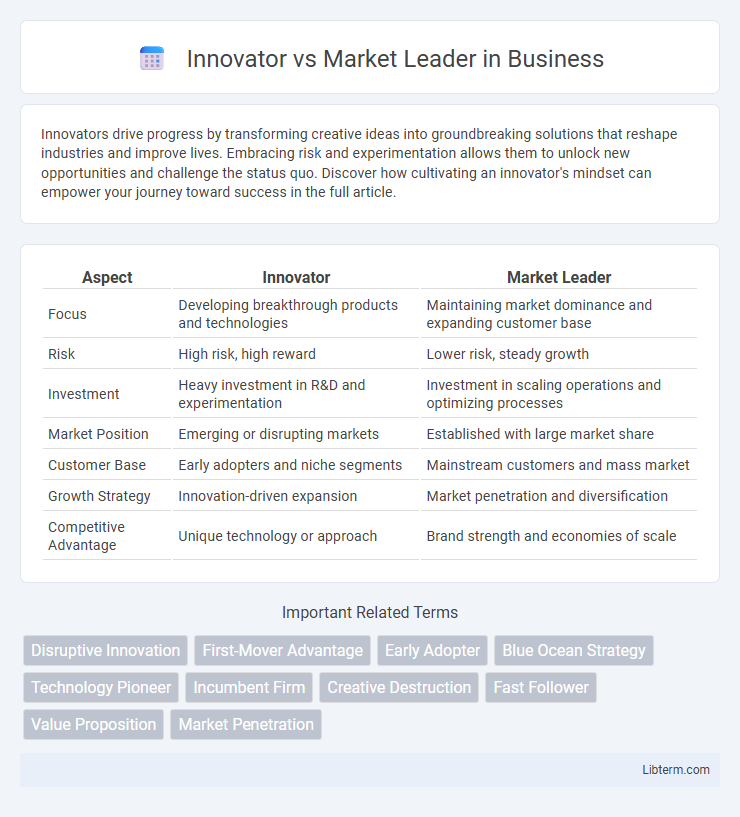Innovators drive progress by transforming creative ideas into groundbreaking solutions that reshape industries and improve lives. Embracing risk and experimentation allows them to unlock new opportunities and challenge the status quo. Discover how cultivating an innovator's mindset can empower your journey toward success in the full article.
Table of Comparison
| Aspect | Innovator | Market Leader |
|---|---|---|
| Focus | Developing breakthrough products and technologies | Maintaining market dominance and expanding customer base |
| Risk | High risk, high reward | Lower risk, steady growth |
| Investment | Heavy investment in R&D and experimentation | Investment in scaling operations and optimizing processes |
| Market Position | Emerging or disrupting markets | Established with large market share |
| Customer Base | Early adopters and niche segments | Mainstream customers and mass market |
| Growth Strategy | Innovation-driven expansion | Market penetration and diversification |
| Competitive Advantage | Unique technology or approach | Brand strength and economies of scale |
Defining the Innovator and the Market Leader
The innovator pioneers breakthrough technologies or business models that disrupt existing markets and create new opportunities. The market leader, conversely, dominates the industry by commanding the largest market share and setting competitive standards. While innovators drive change through creativity and risk-taking, market leaders excel in scaling operations and sustaining long-term profitability.
Key Characteristics of Innovators
Innovators are characterized by their focus on pioneering technologies and breakthrough ideas that disrupt existing markets. They prioritize experimentation, agile development, and risk-taking to rapidly create novel products or services. Their organizational culture encourages creativity, continuous learning, and a willingness to challenge industry norms to gain competitive advantages.
Essential Traits of Market Leaders
Market leaders demonstrate essential traits such as customer-centric innovation, operational excellence, and strong brand equity, which collectively sustain their competitive advantage. They consistently leverage data-driven insights to anticipate market trends and optimize product offerings, ensuring high customer satisfaction and loyalty. Robust financial performance and strategic agility enable market leaders to invest in scalable growth initiatives and maintain industry dominance.
Innovation Strategies vs. Market Domination
Innovators prioritize breakthrough innovation strategies to disrupt existing markets and create new demand, leveraging cutting-edge technologies and agile development cycles. Market leaders focus on sustaining market domination through incremental improvements, robust operational efficiencies, and expansive brand loyalty. While innovators drive transformation through risk-taking and novel solutions, market leaders capitalize on scale, distribution networks, and customer retention to maintain competitive advantage.
Advantages of Being an Innovator
Innovators gain a competitive edge by introducing breakthrough products and technologies that shape market trends and consumer preferences. Their ability to swiftly adapt and experiment fosters continuous improvement and differentiation, attracting early adopters and building brand loyalty. This proactive approach often leads to establishing new market segments and setting industry standards before competitors.
Strengths of a Market Leader
Market leaders possess extensive brand recognition and customer loyalty, enabling them to command higher market shares and set industry standards. Their robust financial resources facilitate large-scale marketing campaigns, product development, and strategic acquisitions to maintain dominance. Market leaders also benefit from established distribution networks and economies of scale, resulting in cost advantages and greater bargaining power with suppliers.
Challenges Faced by Innovators and Market Leaders
Innovators face challenges such as high research and development costs, market uncertainty, and the risk of technology obsolescence. Market leaders encounter obstacles including maintaining market share, managing scale inefficiencies, and responding to competitive disruptions. Both must navigate evolving consumer preferences and regulatory landscapes to sustain growth and relevance.
Case Studies: Iconic Innovators and Market Leaders
Apple exemplifies an iconic innovator by revolutionizing personal technology with the iPhone, while Samsung demonstrates market leadership through its expansive global smartphone sales and diverse product offerings. Tesla reshaped the automotive industry by pioneering electric vehicles and autonomous driving technologies, contrasting with Toyota's market dominance rooted in mass production and hybrid technology leadership. These case studies reveal how innovators disrupt industries with groundbreaking products, whereas market leaders maintain dominance via scale, brand strength, and incremental improvements.
How Innovators Can Become Market Leaders
Innovators can become market leaders by consistently investing in research and development to refine their products and meet evolving customer needs. Strategic partnerships and effective marketing campaigns amplify brand visibility and consumer trust, driving market penetration. Leveraging data analytics to anticipate market trends enables innovators to adapt swiftly, securing a competitive advantage and expanding their market share.
Future Trends: The Evolving Role of Innovation and Leadership
Innovators drive future trends by introducing groundbreaking technologies and business models that redefine industries and consumer expectations. Market leaders leverage their established resources and customer base to scale innovations and shape market standards, often focusing on sustainability and digital transformation. The evolving role of innovation and leadership requires a synergistic approach where continuous adaptation to emerging technologies like AI, IoT, and blockchain determines long-term competitive advantage.
Innovator Infographic

 libterm.com
libterm.com